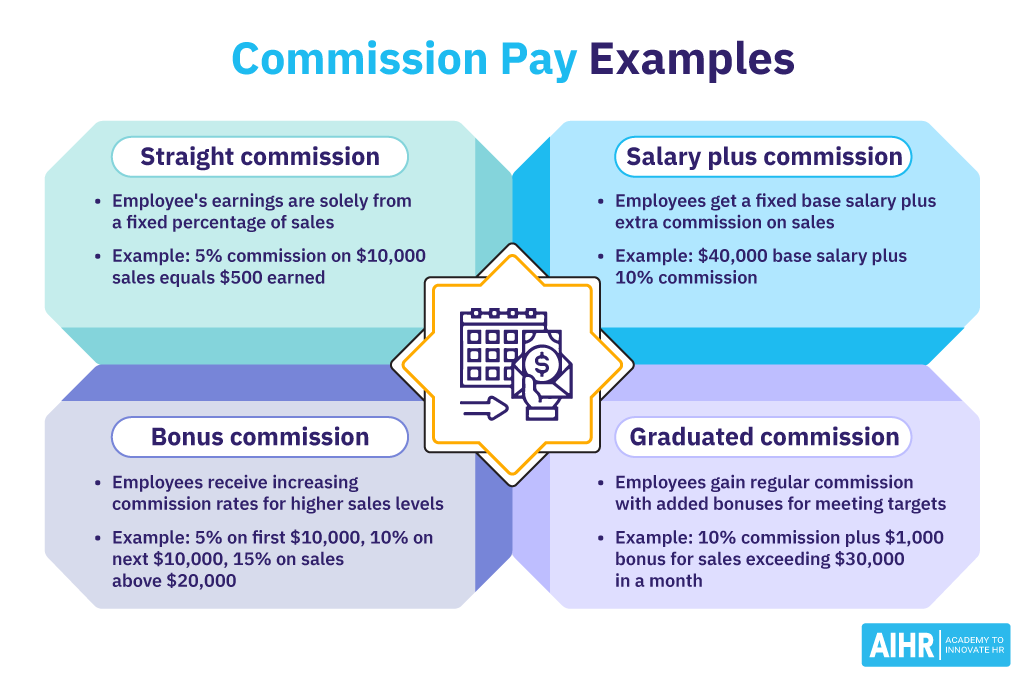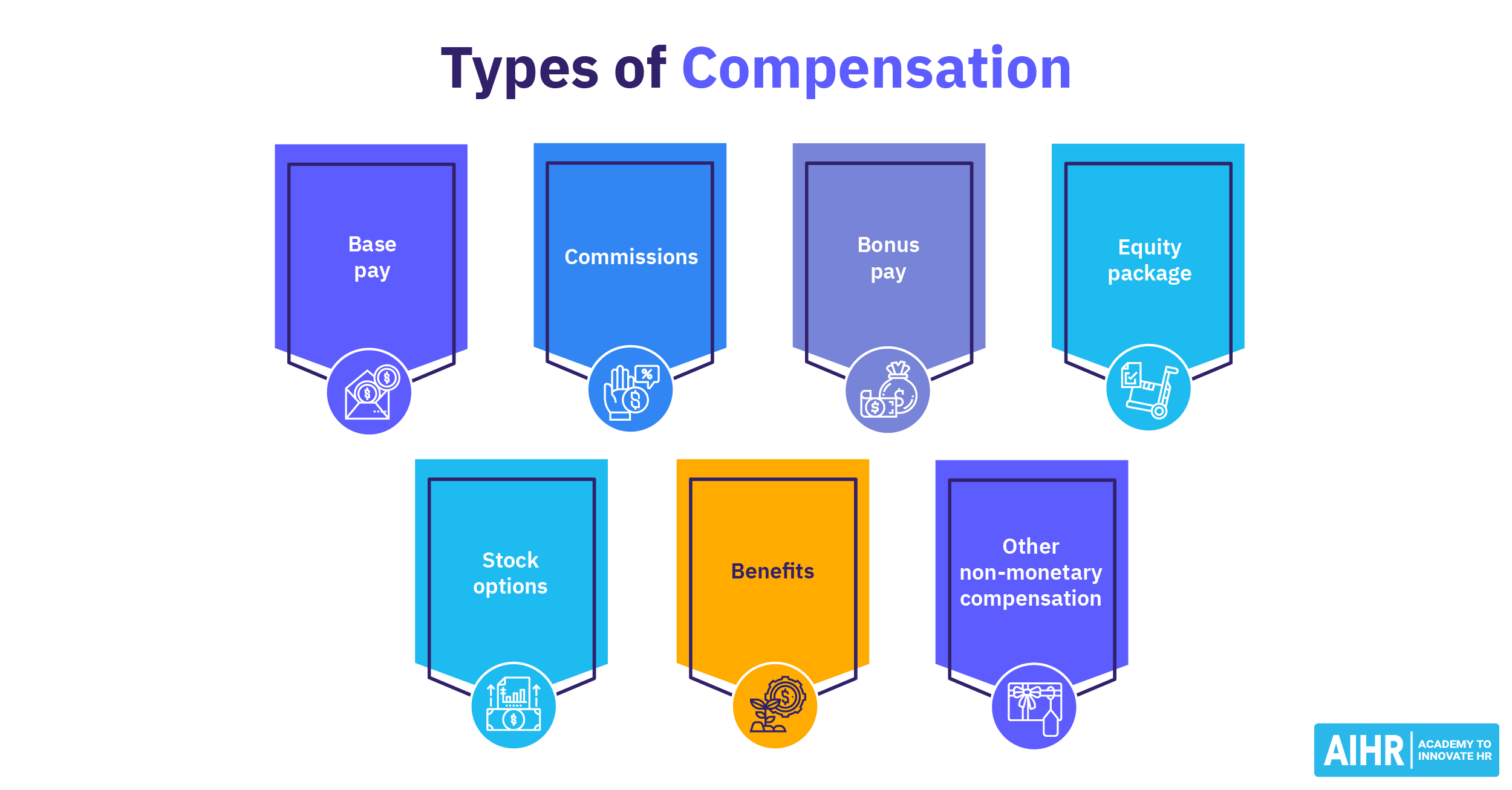Commission Pay
What is commission pay?
Commission pay is a type of variable compensation where employees earn based on their performance, typically tied to the volume or value of sales they generate. This approach is especially common in sales roles, as it encourages higher sales and larger transactions.
In most cases, an employee must be paid a gross wage or salary in addition to their commission pay. However, in some cases, an employee’s earnings may come solely from commission, calculated from their total sales or performance over each pay period.
Below are some examples of jobs that pay commissions:
- Real estate agents typically earn a percentage of property sales.
- Car salespersons commonly earn a percentage of each vehicle sold.
- Sales representatives in retail, wholesale, or corporate sales roles often earn a commission in proportion to their sales volumes.
- Recruiters may earn a commission based on the salaries of candidates they successfully place.
- Insurance agents are often paid based on policies sold, incentivizing customer acquisition and policy renewals.

How does commission pay work?
Under a commission pay system, an employee’s earnings are directly tied to their performance. Companies set commission rates, which are usually a percentage of each sale or of the total amount of sales over a defined period. This means commissions can vary widely depending on the industry, company, and terms of employment.
To calculate commission payouts, companies first define the commission rate and the timeframe it applies to, such as 1% of each transaction or 5% of total monthly sales. Sales results are tracked over that period and then multiplied by the predefined commission percentage rate to derive the payout amount owed. For example, if a salesperson made $30,000 in total sales last month at a 5% commission rate, their commission-based pay for the period would be $30,000 x 0.05 = $1,500.
Regardless of the commission structure, employers must ensure their pay practices comply with minimum wage and labor laws. This means if their commission does not equal minimum wage, the employer may need to make up the difference.
Gain the expertise to design effective commission structures
Commission-based pay can drive performance, but crafting a fair and compliant commission structure requires nuanced understanding.
In AIHR’s Compensation & Benefits Certificate Program, you’ll learn how to create commission frameworks that align with business goals, motivate employees, and comply with wage laws.
This online, self-paced program will equip you with the skills to develop diverse pay structures, analyze compensation data, and manage the legal aspects of employee earnings effectively.
Commission pay examples
Employers can offer several types of commission pay structures. Each one creates a different form of incentivization based on the role and the performance goals the employer wants employees to achieve.
1. Straight commission
Employees do not receive base pay and only earn a fixed percentage of the value of the sales they generate. For example, if an employee sells $10,000 worth of products and the commission rate is 5%, they would earn $500.
2. Salary plus commission
Employees receive a base salary plus a commission based on the sales they make. For instance, an employee might have a base salary of $40,000 per year plus a 10% commission on sales.
3. Graduated commission
Employees earn an increasing percentage of commissions for reaching higher levels of sales or performance numbers. For example, an employee might earn a 5% commission on sales up to $10,000, 10% on sales between $10,001 and $20,000, and 15% on sales above $20,000.
4. Bonus commission
Employees are paid regular commission payments but with an additional bonus for reaching certain targets or milestones. For instance, an employee might earn a standard 10% commission on all sales, but if they exceed the target of $30,000 in a month, they might receive an additional bonus commission of $1,000.

Pros and cons of commission-based pay
Some of the most common advantages of commission pay include:
- Motivation for higher performance: Employees on commission are motivated to work harder, sell more, and improve their performance, as their income is directly tied to their results.
- Flexibility in pay structure: Employers can adjust commission rates and structures based on business needs, market conditions, or employee performance, allowing for more dynamic labor cost management.
- Attracting and retaining talent: A commission-based structure can attract high-performing, ambitious employees who are confident in their sales skills and motivated by the prospect of potentially higher earnings.
- Reduced fixed costs: For employers, commission-based pay helps manage fixed costs effectively, as compensation varies according to sales performance. This aspect is particularly beneficial for businesses experiencing fluctuating sales volumes.
Some of the disadvantages of commission pay are:
- Potential impact on mental health: The pressure to meet sales targets to earn a decent income can lead to stress and burnout, affecting employee wellbeing and productivity.
- Lower quality of work: Employees might prioritize quantity over quality, focusing on making more sales rather than the best sales or providing excellent customer service.
- Income inconsistency for employees: The variability in earnings can be a demotivating factor for some employees, especially during low sales periods. This inconsistency can contribute to higher turnover rates.
- Conflict between employees: Commission structures can foster unhealthy competition among employees, leading to conflict and a negative work environment.
How to calculate commission pay
If you calculate commission pay based on sales, the standard formula is as follows:
| Commission pay = | Sale amount x Commission rate |
Let’s say your commission rate is 20%, and an employee closes a $15,000 sale. Their pay for this sale would be:
$15,000 x 0.20 = $3,000
In another example, a retail employee who closes $5,000 worth of sales in a day, with a commission rate of 15%, would earn:
$5,000 x 0.15 = $750
Of course, the commission can also be paid at a flat rate. if a technician with a base salary of $3,000 per month earns a $50 commission for each system installed, and they install 40 systems in one month, their earnings would be:
($50 x 40 = $2,500 commission pay) + $3,000 base salary = $5,500 monthly pay
What to keep in mind
When creating commission pay policies, ensure they comply with legal pay requirements, including minimum wage laws and correct employee classification. For instance, remote workers shouldn’t be classified as traveling sales professionals. Design commission guidelines carefully, aligned with labor laws and each employee’s role.









